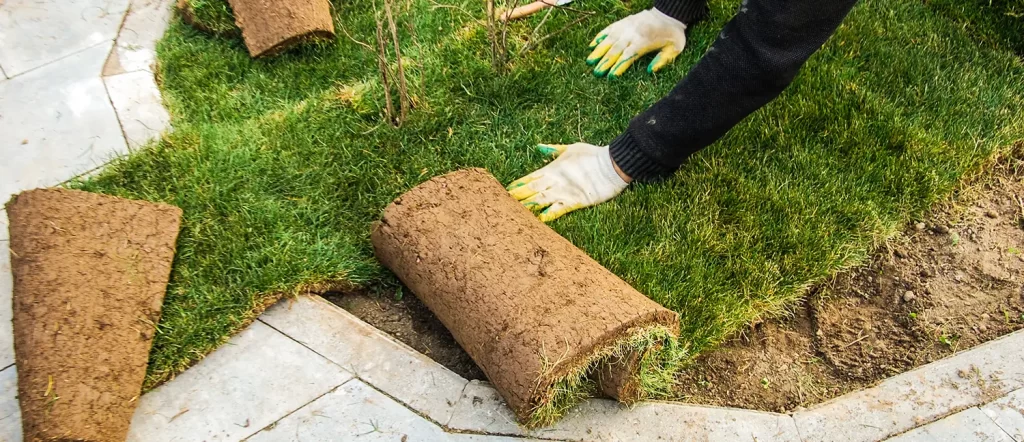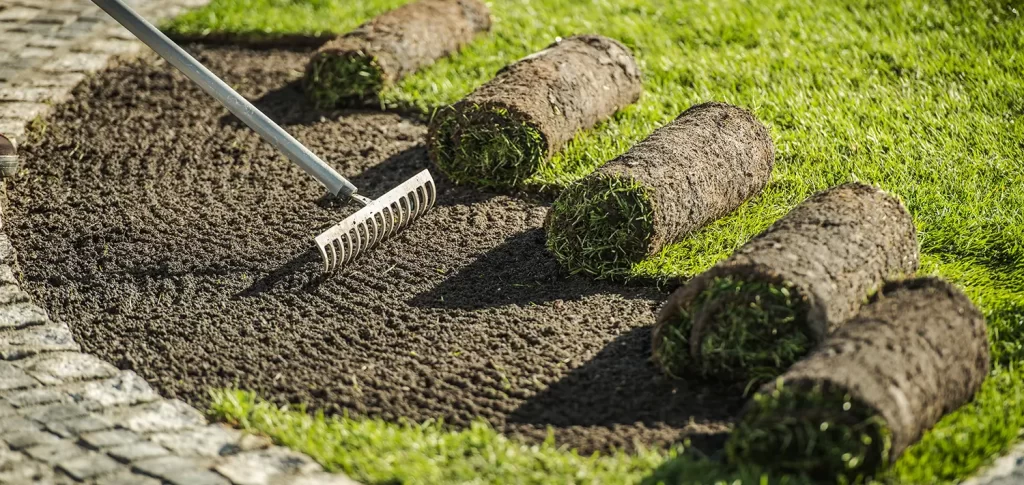
Laying turf can transform your garden into a lush, green paradise. However, the process becomes a bit more challenging when you have obstacles like trees, paths, or corners. You can seamlessly lay turf around these features with the right approach, creating a flawless landscape. In this step-by-step guide, we’ll explore how to navigate these obstacles and ensure your turf makes perfect contact with the soil to promote healthy growth.
Preparing the Area
Before you start laying turf, it’s crucial to prepare the ground properly. The first step is removing weeds, rocks, old turf, and any debris that might prevent the new turf from establishing a strong connection with the soil. This ensures your lawn will have a uniform and smooth finish.
Next, improve the soil surface by adding organic matter or topsoil, which enhances drainage and nutrient availability. A well-prepared soil base is critical to the success of your newly laid turf, especially around obstacles where roots and other elements can disrupt the turf’s ability to thrive.
Lastly, take the time to lay out a precise plan. Measure the area and consider the shape of the obstacles, making sure to account for the space around trees, paths, and corners. Planning is essential to avoid gaps and ensure proper turf placement.
Laying Turf Around Trees
Laying turf around trees requires extra care due to the presence of roots and shade. The key is to minimize disruption to the tree while ensuring the turf can establish itself. Start by clearing the soil around the base of the tree, removing any debris and levelling the surface. Be cautious when digging so as not to damage the tree roots.
When cutting the turf, use a sharp spade or knife to carefully shape the pieces to fit around the tree’s base. Make sure the turf makes good contact with the soil to encourage strong root growth.
It’s also important to select turf that tolerates shade if the tree’s canopy blocks sunlight. After the turf is laid, lightly press it down to ensure it has a solid connection to the soil, then thoroughly water your lawn to help the roots settle.
Finally, avoid walking on the newly laid turf for at least 24 hours to prevent shifting or uneven rooting, especially around sensitive areas like tree bases.
Laying Turf Around Paths
When laying turf next to paths, attention to detail is critical to achieving a clean, professional look. Start by ensuring the edges of the path are well-defined and tidy. You’ll want to prepare the ground around the path by levelling the soil and ensuring there are no gaps or uneven areas.
Turf with a spade should be carefully cut to fit along the edges of the path. Make sure the pieces of turf are snug against the path, with no visible gaps. Once laid, press the turf firmly into place to ensure proper contact with the soil.
To maintain a neat appearance over time, consider placing a small border of stones or mulch between the turf and path to prevent overgrowth. Regularly trim the edges to keep the boundary between the turf and the path crisp and clear.
After laying, thoroughly water the area. Just like when laying turf around trees, avoiding walking on the newly laid turf, especially along the edges, is vital to prevent shifting or damage. Over the coming weeks, ensure the grass remains well-watered and healthy so it can firmly root next to the path.

Laying Turf Around Corners
Laying turf around corners requires patience and precision. Corners often pose a challenge because it’s easy for the turf to shift or pull away if not carefully installed. The trick is to cut the turf accurately to fit the shape of the corner without stretching or forcing it into place.
Use a spade to make sharp, precise cuts when cutting turf for corners. Lay the turf so that the edges meet neatly without overlapping or leaving gaps. Once laid, gently press down the turf to ensure strong contact with the soil surface, which will help the turf settle in and establish itself.
Corners can be prone to pulling away or drying out faster than other areas, so it’s essential to water your lawn thoroughly after installation. This will help the turf root deeply and maintain its shape. Be careful not to overwater, but make sure the turf stays moist during the initial rooting phase.
Allow the turf to establish for about two to three weeks before you start mowing your new lawn. During this period, avoid walking on the turf, especially around corners, to prevent any damage to the developing roots.
General Tips and Tricks
To ensure your newly laid turf thrives, there are a few key tips to keep in mind:
- Turf Handling: Lay the turf as soon as possible after delivery to prevent it from drying out. If you can’t lay it immediately, keep it moist and out of direct sunlight.
- Watering: Water the newly laid turf immediately and continue to keep it well-watered for the first few weeks. Turf needs a lot of moisture in the early stages to establish roots.
- Maintenance: Once the turf has rooted, begin a regular mowing schedule, but don’t mow too short on the first cut—gradually lower the height over time.
Ensure a Perfect Lawn
Laying turf around obstacles like trees, paths, and corners may seem daunting, but with careful planning and execution, it’s entirely achievable. By following this step-by-step approach, ensuring strong contact with the soil, and properly preparing the ground, you can create a lush, green lawn even in areas with tricky obstacles. Remember to give your newly laid turf the right care, from watering to mowing, and avoid common mistakes like walking on it too soon. With patience and attention to detail, your turf will flourish, enhancing the beauty of your lawn.If you’re ready to transform your lawn or have questions, don’t hesitate to contact us for expert advice and professional turf-laying services.